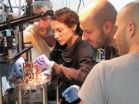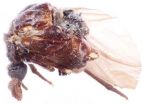(Press-News.org) Superconductors are futuristic materials that will hopefully have a broad range of technological applications at some time in the future (medical imaging, transport…). Today's use is limited by the extremely low temperatures (close to absolute zero) required for superconductivity to manifest. However, some families of these materials work at "relatively" high temperatures (about - 200° C), and it's on these that scientists are focusing their attention. Among them are copper-based superconductors, which have very unique characteristics. A study conducted by researchers of the International School for Advanced Studies (SISSA) of Trieste, the iLamp laboratory of the Catholic University of the Sacred Heart (Brescia), the T-Rex laboratory of the Elettra Synchrotron (Trieste), the Department of Physics of the University of Trieste and other international centres analysed a phenomenon typical of these materials and known to scientists as the pseudogap.
"When the material is heated to above the critical temperature, under which superconductivity manifests itself", explains Massimo Capone a SISSA researcher who took part in the study, "some of the features of the superconductive state are preserved, even though the main one is lost. This condition is called a pseudogap".
The team conducting the study induced a pseudogap state in the material, which it then subjected to very short pulses of laser light. "This treatment made the superconductor temporarily more 'metallic', a state not normally manifested in this condition. We then interrupted the pulses and observed how the material behaved when it returned to its original state", continues Capone. "What we induced is in fact a transient state - lasting less than a picosecond - which we realised was related to electron-electron interactions. The light pulses remove these interactions, making the electrons freer to flow: hence the metallic state".
Capone, whose role in this (mainly experimental) study was to contribute to interpreting the data collected, explains that it's most probably the electron-electron interactions that are responsible for the pseudogap state.
"In addition to offering a theoretical framework for the phenomenon and providing new insight into this major family of superconductors, our study opens to an important possibility of controlling and modulating the characteristics of superconductors through the use of laser light".
INFORMATION:
Flashes of light on the superconductor
Using light to modulate the properties of a copper-based superconductor
2014-07-14
ELSE PRESS RELEASES FROM THIS DATE:
New theory turns cancer on its head
2014-07-14
A new theory of how cancer works could lead to the next generation of treatments of the disease.
The theory suggests that cancer forms when recently evolved genes are damaged, and cells have to revert to using older, inappropriate genetic pathways.
Astrobiologists Dr Charley Lineweaver from The Australian National University and Professor Paul Davies from Arizona State University teamed up with oncologist Dr Mark Vincent from the University of Western Ontario to develop the new model.
"The rapid proliferation of cancer cells is an ancient, default capability that ...
3D printed anatomy to mark a new era for medical training
2014-07-14
The creators of a unique kit containing anatomical body parts produced by 3D printing say it will revolutionise medical education and training, especially in countries where cadaver use is problematical.
The '3D Printed Anatomy Series', developed by experts from Monash University, is thought to be the first commercially available resource of its kind. The kit contains no human tissue, yet it provides all the major parts of the body required to teach anatomy of the limbs, chest, abdomen, head and neck.
Professor Paul McMenamin, Director of the University's Centre for ...
Physical fitness associated with less pronounced effect of sedentary behavior
2014-07-14
ATLANTA – July 14, 2014 –Physical fitness may buffer some of the adverse health effects of too much sitting, according to a new study by researchers from the American Cancer Society, The Cooper Institute, and the University of Texas. The study appears in the journal Mayo Clinic Proceedings, and finds the association between prolonged sedentary time and obesity and blood markers associated with cardiovascular disease is markedly less pronounced when taking fitness into account.
Sedentary behavior has been linked to an increase risk of obesity, metabolic syndrome, type ...
Domestication syndrome: White patches, baby faces and tameness
2014-07-14
More than 140 years ago, Charles Darwin noticed something peculiar about domesticated mammals. Compared to their wild ancestors, domestic species are more tame, and they also tend to display a suite of other characteristic features, including floppier ears, patches of white fur, and more juvenile faces with smaller jaws. Since Darwin's observations, the explanation for this pattern has proved elusive, but now, in a Perspectives article published in the journal GENETICS, a new hypothesis has been proposed that could explain why breeding for tameness causes changes in such ...
UEA research reveals how cannabis compound could slow tumour growth
2014-07-14
Scientists at the University of East Anglia have shown how the main psychoactive ingredient in cannabis could reduce tumor growth in cancer patients.
Research published today reveals the existence of previously unknown signaling platforms which are responsible for the drug's success in shrinking tumours.
It is hoped that the findings could help develop a synthetic equivalent with anti-cancer properties.
The research was co-led with the Universidad Complutense de Madridin, Spain. The team used samples of human breast cancer cells to induce tumours in mice. They ...
The world's first photonic router
2014-07-14
Weizmann Institute scientists have demonstrated for the first time a photonic router – a quantum device based on a single atom that enables routing of single photons by single photons. This achievement, as reported in Science magazine, is another step toward overcoming the difficulties in building quantum computers.
At the core of the device is an atom that can switch between two states. The state is set just by sending a single particle of light – or photon – from the right or the left via an optical fiber. The atom, in response, then reflects or transmits the next incoming ...
Serendipity at the Smithsonian: The 107-year journey of the beetle Rhipidocyrtus muiri
2014-07-14
Serendipity leads University of Kansas scientists to the discovery and description of Rhipidocyrtus muiri - a 107 year old, lost in collections specimen, which turned out to represent a new genus and species. The long and tortuous history of the enigmatic ripidiine wedge beetle from Borneo is discussed in a recent paper published in the open access journal ZooKeys.
The holotype male, and only known specimen of Rhipidocyrtus muiri, was collected 107 years ago in Borneo but subsequent to this it was transferred among several researchers in the early 1900s. The specimen ...
Best for bees to be stay-at-homes
2014-07-14
Honey bees with roots in the local environment manage much better in the struggle for survival than imported honey bees from foreign environments.
A world without bees would be a whole lot poorer – literally. In Denmark alone an additional 600 million to 1 billion Danish kroner are earned annually due to the work done by bees making honey and pollinating a wide range of crops from apples to cherries and clover.
Unfortunately, bees all over the world are under pressure from pesticides, mites, viruses, bacteria, fungi and environmental changes, among other things. The ...
Molecular mechanisms underlying the prevention of autoim-munity by Roquin revealed
2014-07-14
The Roquin protein, discovered in 2005, controls T-cell activation and differentiation by regulating the expression of certain mRNAs. In doing so, it helps to guarantee immunological tolerance and prevents immune responses against the body's own structures that can lead to autoimmune disease. Roquin is thus an immune regulator. Autoimmune diseases affect between five and ten per cent of the population. They usually occur as a result of complex environmental influences when a genetic predisposition exists. Only in rare cases the development of the disease is determined by ...
Flower development in 3D: Timing is the key
2014-07-14
In close collaboration with Jürg Schönenberger and Yannick Städler from the Department of Botany and Biodiversity Research of the Faculty of Life Sciences, University of Vienna, 14 developmental stages of the flower of Arabidopsis thaliana from very early meristematic floral initiation to fully developed seeds were monitored with micro-computed tomography in 3D. From the same set of developmental stages a full metabolic profile using mass spectrometry was measured covering hundreds of biochemical pathways.
"Smallest changes in floral organ development were thus correlated ...
LAST 30 PRESS RELEASES:
Interaction of climate change and human activity and its impact on plant diversity in Qinghai-Tibet plateau
From addressing uncertainty to national strategy: an interpretation of Professor Lim Siong Guan’s views
Clinical trials on AI language model use in digestive healthcare
Scientists improve robotic visual–inertial trajectory localization accuracy using cross-modal interaction and selection techniques
Correlation between cancer cachexia and immune-related adverse events in HCC
Human adipose tissue: a new source for functional organoids
Metro lines double as freight highways during off-peak hours, Beijing study shows
Biomedical functions and applications of nanomaterials in tumor diagnosis and treatment: perspectives from ophthalmic oncology
3D imaging unveils how passivation improves perovskite solar cell performance
Enriching framework Al sites in 8-membered rings of Cu-SSZ-39 zeolite to enhance low-temperature ammonia selective catalytic reduction performance
AI-powered RNA drug development: a new frontier in therapeutics
Decoupling the HOR enhancement on PtRu: Dynamically matching interfacial water to reaction coordinates
Sulfur isn’t poisonous when it synergistically acts with phosphine in olefins hydroformylation
URI researchers uncover molecular mechanisms behind speciation in corals
Chitin based carbon aerogel offers a cleaner way to store thermal energy
Tracing hidden sources of nitrate pollution in rapidly changing rural urban landscapes
Viruses on plastic pollution may quietly accelerate the spread of antibiotic resistance
Three UH Rainbow Babies & Children’s faculty elected to prestigious American Pediatric Society
Tunnel resilience models unveiled to aid post-earthquake recovery
Satellite communication systems: the future of 5G/6G connectivity
Space computing power networks: a new frontier for satellite technologies
Experiments advance potential of protein that makes hydrogen sulfide as a therapeutic target for Alzheimer’s disease
Examining private equity’s role in fertility care
Current Molecular Pharmacology achieves a landmark: real-time CiteScore advances to 7.2
Skeletal muscle epigenetic clocks developed using postmortem tissue from an Asian population
Estimating unemployment rates with social media data
Climate policies can backfire by eroding “green” values, study finds
Too much screen time too soon? A*STAR study links infant screen exposure to brain changes and teen anxiety
Global psychiatry mourns Professor Dan Stein, visionary who transformed mental health science across Africa and beyond
KIST develops eco-friendly palladium recovery technology to safeguard resource security
[Press-News.org] Flashes of light on the superconductorUsing light to modulate the properties of a copper-based superconductor




